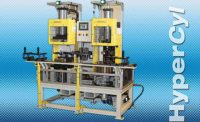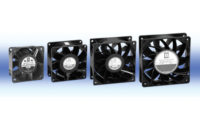Manufacturers today are trapped in a perennial race to get products assembled and out the door in less time and at lower cost while maintaining high quality. They must also adjust to constant change in the materials they use.
These challenges have many companies rethinking their default use of fasteners and liquid adhesives as the best ways to attach metal, plastic and glass. One alternative that is increasingly—and justifiably—gaining engineers’ attention is high-strength bonding tape that contains acrylic foam or glazing.
Many Benefits
There are several advantages to using high-strength bonding tape for assembly. The most important is that the tape bonds instantly. It also is quicker to use than structural silicone, for example.
For assembling commercial window units, structural silicone sealant takes approximately 24 hours to 21 days to fully cure. In contrast, pressure-sensitive acrylic foam bonds two substrates together on contact with no drying time. And a structural glazing tape, such as VHB made by 3M, takes approximately 30 minutes to apply, with zero wait for curing.
High-strength tape is more resilient than the general-purpose foam tape purchased at the local home building supply store. To be sure, the latter is great for sealing, mounting and insulating. But, it’s not so good at withstanding rigorous applications and conditions, such as extreme heat or cold, moisture, wind and flexing.
Acrylic closed-cell foam tape remains flexible to accommodate material expansion and contraction caused by temperature extremes. Specialty bonding tape also allows for differing expansion and contraction rates of dissimilar substrates, such as plastic bonded to metal.
These types of bonding tape are designed to absorb shock and distribute stress over the entire length of the joined surfaces through a continuous bond. Acrylic closed-cell foam, for instance, has specific properties that absorb shock and impact. It comes in a variety of thicknesses.
Equally important, viscoelasticity gives the bonding tape cohesive strength, allowing it to resist dynamic stresses, absorb static stresses and spread stresses over a large area to reduce stress concentration. The ability to do this allows manufacturers to use thinner, lighter, lower-cost materials than the thicker materials needed for screws or rivets.
Finally, high-strength bonding tape maximizes design flexibility to minimize assembly time. Much of this type of tape is used with precision die-cutting, so that it can fit any shape, size or profile. The tape can also provide full coverage on the back of any item if desired.
Ways to Optimize Bonding
With structural bonding tapes, viscoelasticity is the key to how it holds on to surfaces. Viscoelastic properties allow the tape to flow on a micro scale, causing it to wet out the micro texture of a surface. Even flat surfaces have texture that viscoelastic materials can flow into. Once that physical contact is made with the micro texture, chemical interaction controls the level of anchorage to the substrate.
This characteristic accounts for the tape’s popularity worldwide. To date, VHB Structural Glazing Tape is being applied everywhere from the mirrored ceiling panels at Chicago’s O’Hare Airport, to stainless steel panels on the Walt Disney Concert Hall in Los Angeles, to bonding panels of laminated glass at the Liberty Memorial in Kansas City, MO.
There are several things an assembler can do to enhance vicsoelasticity and create a strong, lasting bond in every application. Number one is cleaning the affected surfaces. Dirt and oil will prevent the physical contact of tape to the substrate, and without chemical bonding, there is no real adhesion. Secondly, physically pressing the tape into the microtexture of the surface allows it to wet out and make the needed contact.
Be aware of temperature as well. Approximately 50 to 60 F is the minimum temperature needed to obtain a fast bond for most VHB tapes. Immediately after pressure is applied, the tape can hold on through temperatures ranging up to 200 F.
More-specialized 3M tapes can support higher temperatures, such as when working with substrates that have a powder coating. If applied prior to the paint coat, the tape must be able to withstand temperatures as high as 450 F in the oven.
Abrasion is another way to improve adhesion. A texture of 180 grit equivalent or finer can increase contact area of the tape and improve adhesion. On the other hand, a coarse texture, such as that found on most molded parts, will greatly limit viscoelastic adhesion.
Adhesion promoters and primers are also worth considering. The liquid promoter is directly applied to the bonding surface. A primer sticks to the hard-to-bond plastic, and then the tape sticks to the primer.
Finally, it is important to always use enough tape to provide adequate strength. For long-term static holding, you need 4 square inches of tape per pound of supported weight, taking into account the safety factor.
When applied according to this guideline, VHB Tapes can withstand decades in full weather exposure, temperature swings and occasional dynamic stresses. It’s worth noting that if you’re expecting significant dynamic stresses, contact the tape manufacturer because this type of bond can be much more complicated.
Substrate Surface Energy: High Vs. Low
Always keep in mind that tape works differently with varying types of surface energy. High-surface energy substrates are more chemically attractive to the tape than low-surface energy substrates and draw the adhesive closer for high bond strength.
Materials with high surface energy include any kind of metal: aluminum, steel, stainless steel or galvanized steel. These have a surface energy rating—expressed in dynes per centimeter—that is much higher than that of plastic.
Substrates with medium to low surface energy include plastics and paints. Plastics in the medium range are relatively easy to stick to; these include ABS, polycarbonate, acrylic, polyester resin and epoxy resin. The latter two are used frequently in composite materials. Plastics that are hard to stick to, such as polyethylene or polypropylene, require special techniques that are best selected after consulting with a tape supplier.
Paints range from having good adhesion by itself to requiring a primer coat. Polyester paints, for example, have high surface energy, while powder coat paints have flow agents that decrease their surface energy.
Recommended Applications
There are four types of applications where viscoelastic high-strength bonding tape works best.
High-strength bonding tape is great at joining panels to frames. Bus manufacturers sometimes use tape to bond the outer roof and side metal skin to the vehicle frame. The benefits of this approach are speed and ease of attachment, instant holding, and the durability to withstand dynamic stress such as wind and weather.
Bonding tape is equally effective at adhering a stiffener, external element or structural glazing to a panel, such as the exterior sidewall of a trailer. Besides speed and ease of use, this approach avoids read-through. The tape foam also reduces vibration and noise caused by flexing of the thin-gauge panel material, such as a commercial baseboard air conditioning unit.
Other recommended applications include applying decorative materials to a firm surface, and bonding lenses or windows to a housing. A common decorative application is adhering a company’s brand label to a household appliance. Tape allows this to be done quickly and easily with long-term reliability. In some cases, the high-strength bonding tape also provides dynamic strength, depending on the substrate.
Manufacturers are increasingly using tape to secure cell phone screens, LCD displays and windows in electrical enclosures. In these applications, the benefits of tape include speed, ease of use, impact absorption, sealing (if die-cut) and aesthetics (thin bond).




